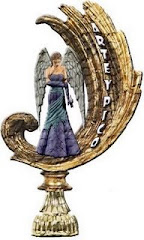
Blue sky reflected in water where the burrowing owl thought it wanted to live.
February 2008 in Sycamore Canyon.
(Click on this or any other photo to enlarge for the best view.)
Photo by Kathie or Gus with Nikon D80 70 to 300mm lens.
In last week's
Skywatch Friday post I wrote about my search for a burrowing owl in a vacant lot in Coolidge, AZ. The post brought many questions about this interesting bird and I promised
Jim that I would write a post and answer his and others' questions.

Burrowing owls got their name because they actually do live underground in burrows. They will use burrows dug by other animals, especially prairie dogs, but they are also capable of digging their own burrows if the need arises. They are found in the open country of the western United States and Florida. Burrowing owls will often line the opening to their burrows with manure to attract insects. When the dung beetles show up, the owls gobble them up. This small 9 ½ inch owl has long legs and is often seen perching on fence posts, or standing on one leg near its burrow. The males and females are roughly the same size, and the breeding season is in April with a clutch of 6 to 10 eggs. The young owlets stay with the parents for up to 40 days with both parents responsible for their care and feeding.
I saw my first burrowing owls in Colorado in the 1990’s. They had taken up residence in a prairie dog town and used the prairie dogs as a warning system for potential danger. The ever alert prairie dogs give a high pitched whistle or bark when danger is sighted. Then everyone disappears below ground until the all clear is given. Since then I have seen burrowing owls in Florida and right here in Sycamore Canyon. I had one show up here around Christmastime last year.

Burrowing Owl in Sycamore Canyon January 2008
It thought the drainage pipe in the wash next to the house would make a great burrow and it hung around for a few weeks until the rain came and filled the wash. Suddenly the little owl discovered it had lake front property. You or I might rejoice at such a discovery, but for the owl, this was bad news. It left the next day and I have not seen it back again since.

Water-filled wash after a
winter storm. February 2008 Sycamore Canyon.
While I was bird watching in Coolidge recently, my son had told me he had seen a little owl standing on the ground in the vacant lot near the school. I assumed right away that it was a burrowing owl. I went searching for it twice.

Does it live here...

...or here?
I found lots of potential burrows, but no owl. Finally on November first in the evening I took a walk over there hoping to find the bird in the rapidly fading light of dusk. By then the dirt and scrub were all the same dull color, and I had just about given up hope. Besides, in that dim light, I was pretty sure my camera would not be able to get as decent photo anyway. Suddenly the little fluff ball flew up in front of me. I tried to follow its flight path and see where it landed, but then I made the mistake of trying to see where it had come from. When I looked back in the direction it had flown, all the clumps of grass and scrub looked exactly the same. In the dim light I saw an outline that I thought might be the bird. It even moved, but closer examination revealed a piece of newspaper stuck in a bush and flapping in the wind.
Due to loss of habitat, the burrowing owl is considered threatened in or endangered in many areas. To see a burrowing owl is a special privilege. I was thrilled to enjoy the company of the one that was in the wash next to my house for the few weeks it was here. I intend to keep on looking for the one in Coolidge. I hope it doesn’t lose its home anytime soon. But development is not the only threat to these little creatures. The vacant lot where I saw it is full of tire tracks from dirt bikes and ATVs. I can’t imagine that this kind of noise and activity is conducive to setting up housekeeping for these birds. In my efforts to see and possibly photograph the owls, I intend to keep a respectful distance so they don’t feel threatened in any way. I want the owl to be there for others to enjoy, now, and in the future.

Burrowing Owl in Sycamore Canyon January 2008
For more fantabulous sky photos visit Skywatch Friday!
To learn more about Burrowing Owls visit these links:

All About Birds: Burrowing Owls
The Owl Pages: Athene cunicularia
Wikipedia: Burrowing Owl
Burrowing Owl Facts Sheet from Saskatchewan Schools
The Peregrine Fund: Burrowing Owl info
Burrowing Owl Program
Sycamore Canyon: Two Birding Incidents
Sycamore Canyon: Burrowing Owl Confirmed
Sycamore Canyon: Evening Owl
Sycamore Canyon: Snow in Arizona
 HAPPY THANKSGIVING!
HAPPY THANKSGIVING! A female great-tailed grackle sits atop a utility pole in Coolidge, AZ on November 2, 2008
A female great-tailed grackle sits atop a utility pole in Coolidge, AZ on November 2, 2008





























































